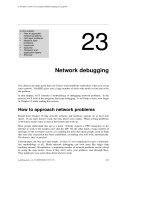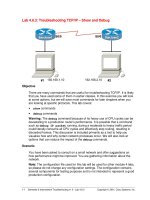Chapter 23 Process-to-Process Delivery: UDP, TCP, and SCTP ppt
Bạn đang xem bản rút gọn của tài liệu. Xem và tải ngay bản đầy đủ của tài liệu tại đây (2.05 MB, 89 trang )
23.1
Chapter 23
Process-to-Process Delivery:
UDP, TCP, and SCTP
Copyright © The McGraw-Hill Companies, Inc. Permission required for reproduction or display.
23.2
23-1 PROCESS-TO-PROCESS DELIVERY
23-1 PROCESS-TO-PROCESS DELIVERY
The transport layer is responsible for process-to-
The transport layer is responsible for process-to-
process delivery—the delivery of a packet, part of a
process delivery—the delivery of a packet, part of a
message, from one process to another. Two processes
message, from one process to another. Two processes
communicate in a client/server relationship, as we will
communicate in a client/server relationship, as we will
see later.
see later.
Client/Server Paradigm
Multiplexing and Demultiplexing
Connectionless Versus Connection-Oriented Service
Reliable Versus Unreliable
Three Protocols
Topics discussed in this section:
Topics discussed in this section:
23.3
The transport layer is responsible for
process-to-process delivery.
Note
23.4
Figure 23.1 Types of data deliveries
23.5
Figure 23.2 Port numbers
23.6
Figure 23.3 IP addresses versus port numbers
23.7
Figure 23.4 IANA ranges
23.8
Figure 23.5 Socket address
23.9
Figure 23.6 Multiplexing and demultiplexing
23.10
Figure 23.7 Error control
23.11
Figure 23.8 Position of UDP, TCP, and SCTP in TCP/IP suite
23.12
23-2 USER DATAGRAM PROTOCOL (UDP)
23-2 USER DATAGRAM PROTOCOL (UDP)
The User Datagram Protocol (UDP) is called a
The User Datagram Protocol (UDP) is called a
connectionless, unreliable transport protocol. It does
connectionless, unreliable transport protocol. It does
not add anything to the services of IP except to provide
not add anything to the services of IP except to provide
process-to-process communication instead of host-to-
process-to-process communication instead of host-to-
host communication.
host communication.
Well-Known Ports for UDP
User Datagram
Checksum
UDP Operation
Use of UDP
Topics discussed in this section:
Topics discussed in this section:
23.13
Table 23.1 Well-known ports used with UDP
23.14
In UNIX, the well-known ports are stored in a file
called /etc/services. Each line in this file gives the name
of the server and the well-known port number. We can
use the
grep utility to extract the line corresponding to the desired
application. The following shows the port for FTP. Note
that FTP can use port 21 with either UDP or TCP.
Example 23.1
23.15
Example 23.1 (continued)
SNMP uses two port numbers (161 and 162), each for a
different purpose, as we will see in Chapter 28.
23.16
Figure 23.9 User datagram format
23.17
UDP length
= IP length – IP header’s length
Note
23.18
Figure 23.10 Pseudoheader for checksum calculation
23.19
Figure 23.11 shows the checksum calculation for a very
small user datagram with only 7 bytes of data. Because
the number of bytes of data is odd, padding is added for
checksum calculation. The pseudoheader as well as the
padding will be dropped when the user datagram is
delivered to IP.
Example 23.2
23.20
Figure 23.11 Checksum calculation of a simple UDP user datagram
23.21
Figure 23.12 Queues in UDP
23.22
23-3 TCP
23-3 TCP
TCP is a connection-oriented protocol; it creates a
TCP is a connection-oriented protocol; it creates a
virtual connection between two TCPs to send data. In
virtual connection between two TCPs to send data. In
addition, TCP uses flow and error control mechanisms
addition, TCP uses flow and error control mechanisms
at the transport level.
at the transport level.
TCP Services
TCP Features
Segment
A TCP Connection
Flow Control
Error Control
Topics discussed in this section:
Topics discussed in this section:
23.23
Table 23.2 Well-known ports used by TCP
23.24
Figure 23.13 Stream delivery
23.25
Figure 23.14 Sending and receiving buffers









